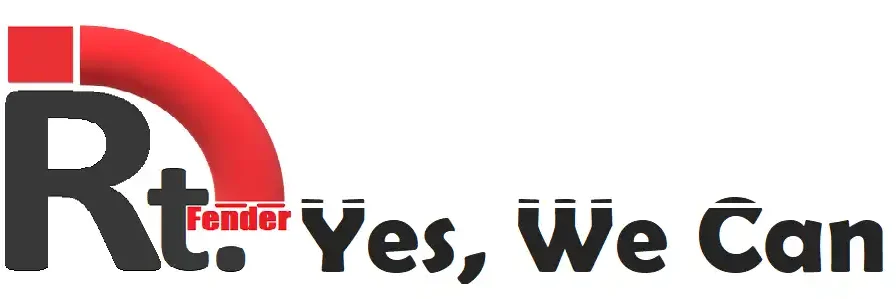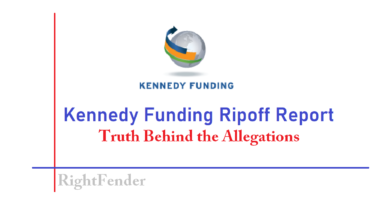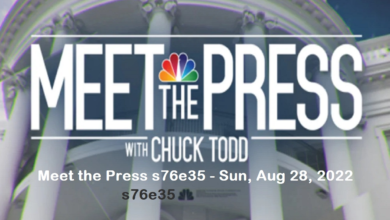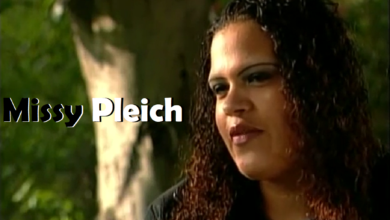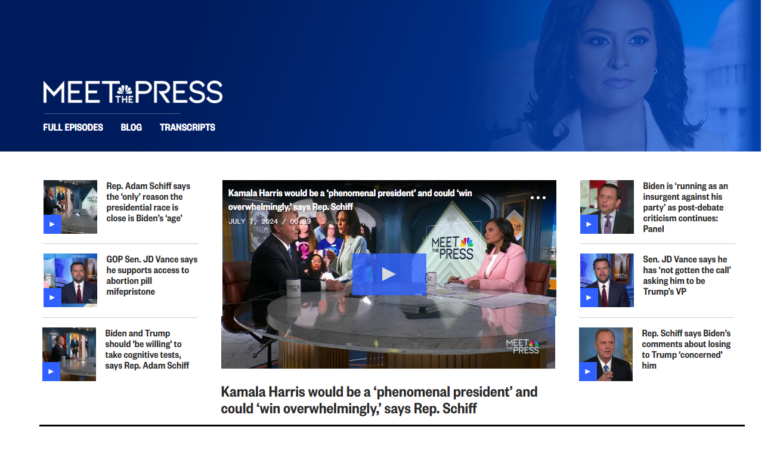
Picture this: It’s November 6, 1947. The world is still recovering from World War II, Harry S. Truman is in the White House, and television is a novelty in American homes. Amidst this backdrop, a pioneering program called “Meet the Press” made its debut. Who could have imagined that this show would become the longest-running program on network television?
Meet the Press wasn’t just a show; it was a revolution. Created by journalist Martha Rountree and producer Lawrence E. Spivak, the program was initially designed to bring politicians and policymakers face-to-face with journalists. The concept was simple yet groundbreaking: a panel of journalists asking tough questions to prominent figures. This wasn’t just news; it was accountability in action. But what made Meet the Press stand out from the get-go?
Rountree’s vision was clear: She wanted a program where the press had the power to question the most influential people of the time. This was not about soft interviews or promotional talk—it was about hard-hitting journalism. And boy, did it deliver! From the beginning, Meet the Press set a high bar for political discourse and journalistic integrity.
- The Evolution of a Journalistic Powerhouse
- The Show Time and Format: A Sunday Morning Staple
- Show Episodes / Seasons
- Memorable Moments: When Meet the Press Made Headlines
- The Impact of Meet the Press on Political Journalism
- The Future of Meet the Press: Adapting to Changing Times
- Conclusion: The Legacy and Promise of Meet the Press
- Frequently Asked Questions (FAQs)
The Evolution of a Journalistic Powerhouse
As television evolved, so did Meet the Press. The show transitioned from radio to television in 1949, and with that move, it expanded its reach exponentially. Imagine families gathered around their TV sets on Sunday mornings, eagerly waiting to see their elected officials grilled on national issues. It was reality TV before reality TV was a thing!
The show’s format, while maintaining its core of tough questioning, adapted to changing times. In the early days, the set was simple, almost austere. No flashy graphics or dramatic music—just a panel of journalists and a guest. But this simplicity worked to its advantage. It stripped away the fluff and focused on the substance: the conversation.
As the decades rolled on, Meet the Press saw numerous format changes and technological upgrades. The 1970s brought color television, which made the program visually more engaging. The 1980s and 1990s saw the rise of satellite technology, allowing for more diverse and timely guest appearances. The digital age ushered in social media integration, making the show more interactive and accessible to a global audience.
Hosts of Meet the Press
If the walls of Meet the Press could talk, they’d tell stories of legendary journalists who have helmed the show. Each moderator brought a unique style, shaping the program’s tone and direction. Let’s take a trip down memory lane and meet some of these iconic figures.
- Martha Rountree (1947-1953): The trailblazing creator and first moderator of Meet the Press, Rountree was a force to be reckoned with. Her vision and leadership set the foundation for what the show would become.
- Lawrence E. Spivak (1966-1975): Spivak, the co-creator, took over the reins after a brief period away from the show. His tenure is remembered for his sharp questioning and unwavering commitment to journalistic integrity.
- Tim Russert (1991-2008): Perhaps the most famous moderator, Russert’s style was a blend of tough questioning and affable demeanor. His ability to ask pointed questions without alienating guests made him a beloved figure in journalism.
- David Gregory (2008-2014): Gregory brought fresh energy to the show, navigating the rapidly changing media landscape with skill and charisma.
- Chuck Todd (2014-2023): Todd has continued the tradition of incisive journalism while integrating modern technologies and platforms to reach a wider audience.
- Kristen Welker (2023–Present): The current moderator, navigating the rapidly changing media landscape with skill and charisma.
Each of these moderators contributed to the show’s legacy, leaving their mark on political journalism. But what made them effective? It wasn’t just their ability to ask tough questions. It was their knack for making complex issues accessible to the average viewer, their relentless pursuit of the truth, and their respect for the intelligence of their audience.
The Show Time and Format: A Sunday Morning Staple
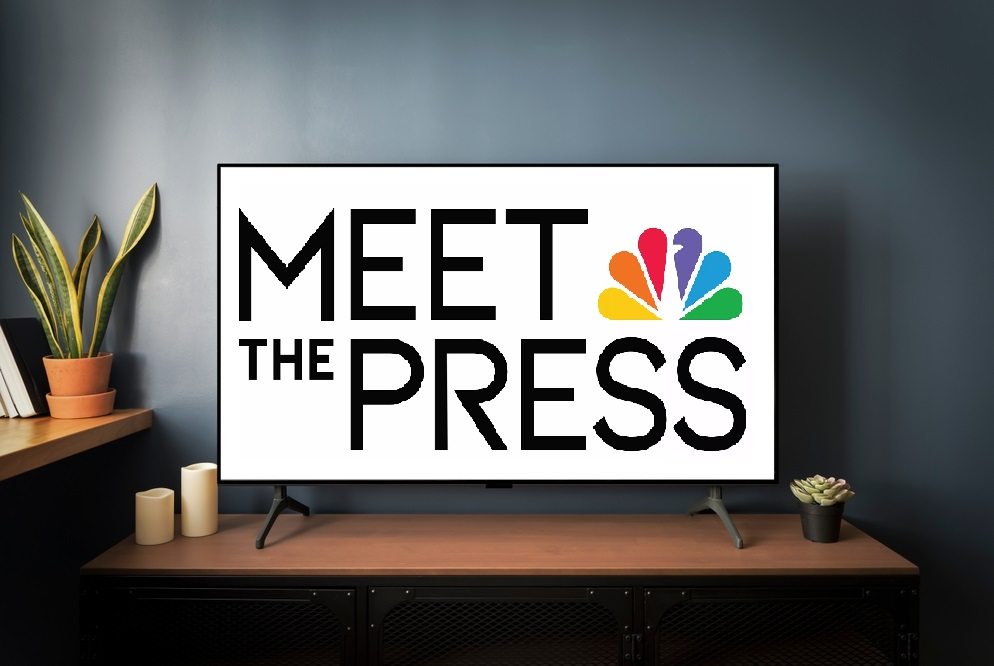
Ah, Sunday mornings. For many, it’s a time for relaxation, perhaps a lazy breakfast in bed. But for political junkies and news enthusiasts, Sunday mornings mean one thing: Meet the Press. Broadcasting at 09:00 AM Eastern Time, the show has become a weekend ritual for millions of Americans.
The format of Meet the Press is designed to keep viewers engaged and informed. Each episode typically features a main guest—often a high-ranking government official, a politician, or an expert in a relevant field. This main interview is followed by a roundtable discussion with journalists and analysts who dissect the interview, providing context and commentary.
The roundtable is where the magic happens. It’s like a mini think-tank session, where diverse opinions collide, and different perspectives are explored. It’s engaging, sometimes heated, but always informative. The roundtable discussions often delve into the week’s biggest news stories, offering insights that go beyond the headlines.
In recent years, the show has expanded its reach through digital platforms. Meet the Press now offers podcasts, web exclusives, and social media interactions, making it more accessible than ever. This multi-platform approach ensures that whether you’re at home, on the go, or at the gym, you can stay connected with the latest political discourse.
Show Episodes / Seasons
“Meet the Press” has been airing for over 75 years, making it one of the longest-running television programs in history. It first premiered on November 6, 1947. Given its continuous weekly broadcasts, it doesn’t follow traditional television seasons. Instead, it has been produced continuously since its inception, amounting to over 3,500 episodes.
However, some other streaming and informative sites like TVGuide categorized the episodes in seasons with shortcodes. TVGuide sorted the episodes into 20 seasons (Season 58 – Season 77). You can easily search for your favorite episode by scrolling down the season. Our internet sleuths shortlisted some most popular episodes with deep analysis, you can access them with a single click by visiting our blog.
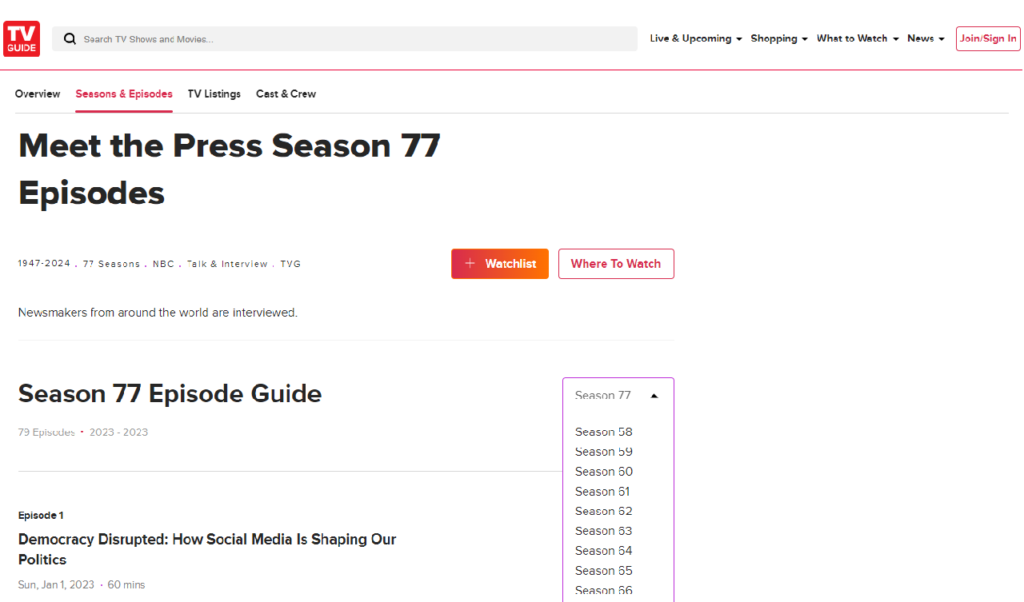
Memorable Moments: When Meet the Press Made Headlines
Over the decades, Meet the Press has had its share of memorable moments—those instances when the show itself became news. Let’s take a look at some of these iconic episodes that made headlines.
- Richard Nixon’s “Checkers” Speech (1952): While not delivered on Meet the Press, Nixon’s famous speech about his dog Checkers was a direct response to allegations discussed on the show. It demonstrated the program’s influence on national politics.
- Senator Joseph McCarthy (1954): During the height of McCarthyism, Meet the Press provided a platform for Senator McCarthy to discuss his controversial anti-communist crusade. The episode remains a critical piece of historical journalism.
- President John F. Kennedy (1960): JFK appeared on Meet the Press multiple times, using the platform to connect with voters and articulate his vision for America. His interviews are a masterclass in political communication.
- Hillary Clinton’s Benghazi Testimony (2013): Secretary of State Hillary Clinton’s appearance on Meet the Press to discuss the Benghazi attack was a pivotal moment in her career, showcasing her ability to handle tough questions under intense scrutiny.
These episodes highlight the show’s role in shaping political narratives and influencing public opinion. Meet the Press isn’t just a passive observer of history; it’s an active participant in the democratic process.
The Impact of Meet the Press on Political Journalism
Meet the Press has had a profound impact on political journalism, setting standards and influencing practices across the industry. But what exactly is this impact, and how has it shaped the field?
Firstly, Meet the Press pioneered the format of the televised political interview. Before its debut, political interviews were often scripted and controlled. Meet the Press introduced an element of unpredictability, with journalists asking unscripted questions and demanding real answers. This format has been emulated by numerous other programs, both in the United States and around the world.
Secondly, the show has elevated the role of journalists in the political process. Meet the Press has shown that journalists are not just passive reporters of news but active participants in the democratic dialogue. The program’s rigorous questioning and in-depth analysis have held politicians accountable, ensuring that they cannot simply spin their way out of tough situations.
Lastly, Meet the Press has democratized political discourse. By bringing political leaders directly into Americans’ living rooms, the show has made politics more accessible to the average citizen. It has educated generations of viewers about complex issues, fostering a more informed electorate.
The Future of Meet the Press: Adapting to Changing Times
As we look to the future, one thing is clear: Meet the Press will continue to evolve. The media landscape is changing at a rapid pace, with new technologies and platforms emerging all the time. How will Meet the Press adapt to these changes while maintaining its core values?
One area of focus will undoubtedly be digital integration. In an era where more people are consuming news online and on mobile devices, Meet the Press is already expanding its digital footprint. The show’s presence on social media platforms like Twitter and Facebook allows for real-time engagement with viewers, while its podcasts and web exclusives cater to a growing audience that prefers on-demand content.
Another potential avenue for growth is international coverage. While Meet the Press has traditionally focused on American politics, the interconnectedness of the global community means that international issues are increasingly relevant to U.S. audiences. Expanding its coverage to include more international perspectives could enhance the show’s relevance and appeal.
Moreover, Meet the Press will continue to emphasize diversity and inclusion, both in terms of the guests it features and the journalists who moderate and participate in the show. A more diverse range of voices can provide richer, more nuanced discussions, reflecting the complexity of the world we live in.
Conclusion: The Legacy and Promise of Meet the Press
Meet the Press is not just a television program; it’s an institution. For over seven decades, it has been at the forefront of political journalism, setting standards, shaping narratives, and holding power to account. From its humble beginnings in 1947 to its current status as a multimedia powerhouse, the show has continuously adapted and evolved, ensuring its relevance in an ever-changing media landscape.
As we look to the future, one thing remains certain: Meet the Press will continue to be a vital part of our democratic process. It will keep asking the tough questions, providing insightful analysis, and fostering informed discourse. In doing so, it will honor its legacy while embracing the promise of a new era in journalism.
So, the next time you find yourself with a cup of coffee on a Sunday morning, tune in to Meet the Press. Join the conversation, engage with the issues, and be a part of this grand tradition. After all, in a world full of noise, Meet the Press remains a beacon of clarity and truth.
Frequently Asked Questions (FAQs)
What time is Meet the Press on?
“Meet the Press” airs on NBC every Sunday at 9:00 AM ET
Who hosts Meet the Press?
Kristen Welker is the current host of “Meet the Press”
Why did Chuck Todd leave Meet the Press?
Chuck Todd announced his departure from “Meet the Press” to spend more time with his family and to focus on other professional endeavors. He also mentioned a desire to ensure a smooth transition to his successor, Kristen Welker, and to step away from the demanding schedule of hosting a weekly news program.
Is Chuck Todd still on Meet the Press?
No, Chuck Todd is no longer the host of “Meet the Press.” He stepped down and Kristen Welker took over as the new host. However, Todd may still appear occasionally as a guest or contributor.
Can I stream Meet the Press live?
Yes, you can stream “Meet the Press” live. The show is available for live streaming on the NBC website, through the NBC app, and on the streaming service Peacock. You might need a TV provider login for the NBC website and app, but Peacock offers the show live as part of its service options.
Is Meet the Press biased?
The perception of bias in “Meet the Press,” like with many news programs, can vary depending on individual perspectives and political leanings. Some viewers might perceive bias based on how topics are covered, the selection of guests, or the framing of questions and issues. However, NBC News, the network that airs “Meet the Press,” aims to present balanced and fair reporting.
